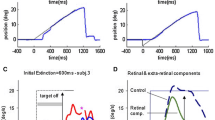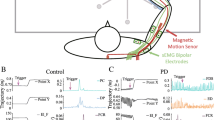Abstract
Quantitative assessment of motor performance is important for diseases of motor control, such as Parkinson’s disease (PD). Manual tracking tasks are well suited for motor assessment, as they can be performed concomitantly with brain mapping techniques. Here we propose utilizing second-order linear dynamical systems to assess manual pursuit tracking performance. With the desired trajectory as the input, and the subject’s actual motor response as the output, a linear model characterized by natural frequency and damping ratio is identified for each subject. We applied this method to 10 PD subjects (on and off l-dopa medication) and 10 normal subjects performing a multi-frequency sinusoidal tracking task. Model parameters were more sensitive than overall tracking errors in determining significant differences between groups. The effect of l-dopa medication was to reduce the damping ratio and make the range in natural frequency across individuals approach that of normal subjects. We interpret the changes in damping ratio and natural frequency as possibly related to suppression of compensatory cerebellar activity and/or improvement of motor program selection, and the changes in natural frequency as an implicit strategy to maintain settling time in the face of reduce damping ratio. Our results suggest that simple linear dynamical system models can be a powerful method to assess tracking performance in Parkinson’s disease because of the additional insight they can provide into neurological processes.







Similar content being viewed by others
References
Abdel-Malek, A., C. Markham, P. Marmarelis, and V. Marmarelis. Quantifying deficiencies associated with Parkinson’s disease by use of time-series analysis. Electroencephalogr. Clin. Neurophysiol. 69(1):24, 1988.
Abdel-Malek, A., and V. Z. Marmarelis. Modeling of task-dependent characteristics of human operator dynamics pursuit manual tracking. IEEE Trans. Syst. Man Cybern. 18(1):163–172, 1988.
Allen, D. P., J. R. Playfer, N. M. Aly, P. Duffey, A. Heald, S. L. Smith, and D. M. Halliday. On the use of low-cost computer peripherals for the assessment of motor dysfunction in Parkinson’s disease—Quantification of bradykinesia using target tracking tasks. IEEE Trans. Neural Syst. Rehabil. Eng. 15(2):286–294, 2007.
Aly, N., J. Playfer, S. Smith, and D. Halliday. A novel computer-based technique for the assessment of tremor in Parkinson’s disease. Age Ageing 36(4):395–399, 2007.
Au, W.-L., N. Lei, M. M. K. Oishi, and M. J. McKeown. L-dopa induces under-damped visually-guided motor responses in Parkinson’s disease. Exp. Brain Res. 202(3):553–559, 2010.
Bar-Gad, I., and H. Bergman. Stepping out of the box: Information processing in the neural networks of the basal ganglia. Curr. Opin. Neurobiol. 11(6):689–695, 2001.
Brainard, D. H. The psychophysics toolbox. Spat. Vis. 10(4):433–436, 1997.
Brogan, W. Modern Control Theory (3rd ed.). Upper Saddle River, NJ: Prentice Hall, 1991.
Davidson, P., R. Jones, J. Andreae, and H. Sirisena. Simulating closed- and open-loop voluntary movement: a nonlinear control-systems approach. IEEE Trans. Biomed. Eng. 49(11):1242–1252, 2002.
Day, B., J. Dick, and C. Marsden. Patients with Parkinson’s disease can employ a predictive motor strategy. J. Neurol. Neurosurg. Psychiatry 47(12):1299, 1984.
Flowers, K. Some frequency response characteristics of Parkinsonism on pursuit tracking. Brain 101(1):19–34, 1978.
Franklin, G., M. Workman, and D. Powell. Digital Control of Dynamic Systems. Boston, MA, USA: Addison-Wesley Longman Publishing Co., Inc, 1997.
Gonzalez, J., E. Heredia, T. Rahman, K. Barner, and G. Arce. Optimal digital filtering for tremor suppression. IEEE Trans. Biomed. Eng. 47(5):664–673, 2000.
Hoshi, E., L. Tremblay, J. Feger, P. L. Carras, and P. L. Strick. The cerebellum communicates with the basal ganglia. Nat. Neurosci. 8:1491–1493, 2005.
Hwang, E. J., M. A. Smith, and R. Shadmehr. Dissociable effects of the implicit and explicit memory systems on learning control of reaching. Exp. Brain Res. 173(3):425–437, 2006.
Johnson, M. T. V., A. N. Kipnis, J. D. Coltz, A. Gupta, P. Silverstein, F. Zwiebel, and T. Ebner. Effects of levodopa and viscosity on the velocity and accuracy of visually guided tracking in Parkinson’s disease. Brain 119(3):801–813, 1996.
Jones, R., M. Donaldson, and B. Sharman. A technique for removal of the visuoperceptual its application to Parkinson’s disease. IEEE Trans. Biomed. Eng. 43(10):1001, 1996.
Jueptner, J., M. Jueptner, I. H. Jenkins, D. J. Brooks, R. S. J. Frackowiak, and R. E. Passingham. The sensory guidance of movement: a comparison of the cerebellum and basal ganglia. Exp. Brain Res. 112(3):462–474, 1996.
Kaji, R., R. Urushihara, N. Murase, H. Shimazu, and S. Goto. Abnormal sensory gating in basal ganglia disorders. J. Neurol. 252:13–16, 2005.
Lemieux, S., M. Ghassemi, M. Jog, R. Edwards, and C. Duval. The influence of levodopa-induced dyskinesias on manual tracking in patients with Parkinson’s disease. Exp. Brain Res. 176(3):465–475, 2007.
Liu, X., R. Osterbauer, T. Z. Aziz, R. C. Miall, and J. F. Stein. Increased response to visual feedback of drug-induced dyskinetic movements in advanced Parkinson’s disease. Neurosci. Lett. 304(1–2):25–28, 2001.
Ljung, L. System Identification Toolbox for Use with Matlab. Natick, MA: The Mathworks. Inc., 1997.
Ljung, L., and E. Ljung. System Identification: Theory for the User. Englewood Cliffs, NJ: Prentice-Hall, 1987.
Manto, M. Mechanisms of human cerebellar dysmetria: experimental evidence and current conceptual bases. J. Neuroeng. Rehabil. 6(1):10, 2009.
Mates, J., and T. Radil. Two-dimensional manual tracking of periodic movements: event and time interval analyses. Int. J. Psychophysiol. 12(2):123–132, 1992.
Miall, R., D. Weir, D. Wolpert, and J. Stein. Is the cerebellum a Smith predictor? J. Mot. Behav. 25(3):203–216, 1993.
Mink, J. The basal ganglia: focused selection and inhibition of competing motor programs. Prog. Neurobiol. 50(4):381–425, 1996.
Ohye, C., N. Tsukahara, and H. Narabayashi. Rigidity and disturbance of reciprocal innervation. Confin. Neurol. 26:24–40, 1965.
Palmer, S., L. Eigenraam, T. Hoque, R. McCaig, A. Troiano, and M. J. McKeown. Levodopa-sensitive, dynamic changes in effective connectivity during simultaneous movements in Parkinson’s disease. Neuroscience 158(2):693–704, 2009.
Palmer, S. J., J. Li, Z. J. Wang, and M. J. McKeown. Joint amplitude and connectivity compensatory mechanisms in Parkinson’s disease. Neuroscience 166(4):1110–1118, 2010.
Palmer, S., B. Ng, R. Abugharbieh, L. Eigenraam, and M. J. McKeown. Motor reserve and novel area recruitment: amplitude and spatial characteristics of compensation in Parkinson’s disease. Eur. J. Neurosci. 29:2187–2196, 2009.
Riviere, C., and N. Thakor. Modeling and canceling tremor in human-machine interfaces. IEEE Eng. Med. Biol. Mag. 15(3):29–36, 1996.
Shadmehr, R., and H. H. Holcomb. Neural correlates of motor memory consolidation. Science 277(5327):821–825, 1997.
Smith, M. A., A. Ghazizadeh, and R. Shadmehr. Interacting adaptive processes with different timescales underlie short-term motor learning. PLoS Biol. 4(6):e179, 2006.
Sugi, T., M. Nakamura, J. Ide, and H. Shibasaki. Modeling of motor control on manual tracking for developing a handmovement-compensation technique. Artif. Life Robotics 7(3):112–117, 2003.
van Donkelaar, P., J. F. Stein, R. E. Passingham, and R. C. Miall. Temporary inactivation in the primate motor thalamus during visually triggered and internally generated limb movements. J. Neurophysiol. 83(5):2780–2790, 2000.
Verdaasdonk, B., H. Koopman, and F. van der Helm. Resonance tuning in a neuro-musculo-skeletal model of the forearm. Biol. Cybern. 96(2):165–180, 2007.
Watson, R., R. Jones, and N. Sharman. Two-dimensional tracking tasks for quantification of sensory-motor dysfunction and their application to Parkinson’s disease. Med. Biol. Eng. Comput. 35(2):141–145, 1997.
Wenzelburger, R., B.-R. Zhang, S. Pohel, S. Klebe, D. Lorenz, J. Herzog, H. Wilms, G. Duschl, and P. Krack. Force overflow and levadopa-induced dyskinesias in Parkinson’s disease. Brain 125:871–879, 2002.
Yu, H., D. Sternad, D. M. Corcos, and D. E. Vaillancourt. Role of hyperactive cerebellum and motor cortex in Parkinson’s disease. Neuroimage 35(1):222–233, 2007.
Acknowledgments
The authors are grateful to Samantha Palmer for assistance in collecting the data. This work was supported in part by a Michael Smith Foundation for Health Research Team Startup Grant (McKeown), by NSERC Discovery Grant #327387 (Oishi), and by an NSERC USRA (TalebiFard).
Author information
Authors and Affiliations
Corresponding author
Additional information
Associate Editor Nathalie Virag oversaw the review of this article.
Rights and permissions
About this article
Cite this article
Oishi, M.M.K., TalebiFard, P. & McKeown, M.J. Assessing Manual Pursuit Tracking in Parkinson’s Disease Via Linear Dynamical Systems. Ann Biomed Eng 39, 2263–2273 (2011). https://doi.org/10.1007/s10439-011-0306-5
Received:
Accepted:
Published:
Issue Date:
DOI: https://doi.org/10.1007/s10439-011-0306-5




